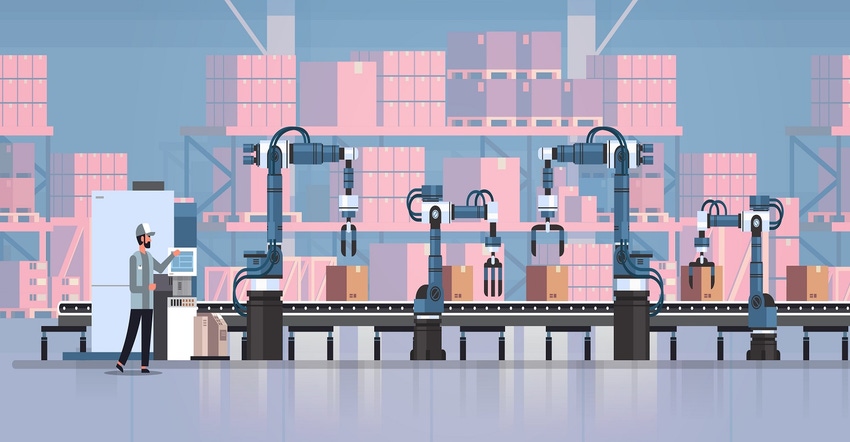Smart machines are created with smart processes. That includes AI, digital twins, and AR.
September 13, 2021

As industrial machines are becoming more connected and flexible, the process of building and commissioning the machine is also getting smarter. Machines are built now using artificial intelligence, digital twins, and augmented reality.
We caught up with Rahul Garg, VP of industrial machinery and mid-market program at Siemens Digital Industries Software. Garg explained the process of creating smart industrial machines using advanced technology.
Design News: Is artificial intelligence becoming a major factor in building industrial machines?
Rahul Garg: When you think of AI, one of the key ingredients is real-time data. It takes a lot of data to improve the way you’re making decisions. If you think about a machine performing under certain conditions, those conditions don’t stay the same. Depending on the environment, the conditions can change. A spinning machine handling soft fabrics changes based on humidity and other environmental factors. Not all machines run in an air-conditioned environment, so being able to monitor the changes and using AI, helps you adapt to the variables. The weaving speed needs to change based on these factors so you don’t mess up the cloth. Maybe you need to stop and send a signal to the right person. You can build upon that and adjust your processes based on the data. So you find a way to gather the data and let AI make the decisions so your decisions will be more pragmatic and effective.
DN: Another aspect of AI is the digital twin. Are digital twins becoming more of a factor in building machines?
Rahul Garg: We use a digital twin when we design machines. All of the things involved in designing the machine are supported by the digital twin. You don’t have to have a physical replica to create the machine. You can look at the digital twin to improve the machine or troubleshoot it. An executable digital twin with AI can demonstrate how the machine is supposed to operate. More and more decisions can be made on the machine by using a virtual replica. That helps us make a smart machine smarter.
DN: How is cloud connectivity playing in building and monitoring machines? How does edge computing fit in?
Rahul Garg: We use cloud solutions for the engineering and the design of the processes themselves. We saw a big jump in cloud use with COVID-19. The cloud made things more possible. The automation folks were connected in a cloud environment to do their engineering and manufacturing work.
The equipment is running at the customer's site. That’s where the cloud becomes interesting. When you’re trying to get data from customers to do proactive maintenance, you need data that shows how the machine is performing. Without the could it would be hard to know that. Using the cloud is part of serving the customer better.
Once the cloud process is started for IoT cloud-based analytics, they realize they need the ability to perform some computing right at the machine site itself. We have to figure out when we need the data to come back to us and when it’s not necessary. We have this whole edge solution for machine builders to manage the data coming from the machines. They need to monitor the machines, but they also need some of the decisions to be made right at the edge.
DN: How about flexibility and agility? Do your customers seek solutions that allow them to change up quickly and easily?
Companies that can deliver a customized machine most efficiently will be the most successful. But much of the content on the machine can be reused from other instances when you’re customizing it. This helps companies reduce their cost while still getting what they want. Modular subsystems and components can be changed and reconfigured to customize the machine. The approach of creating modular machines offers the necessary agility to get the machine changed quickly. If you don’t have the modular approach, you'll have to do more engineering. It will cost you more and it may not serve your customers.
DN: How big a factor is customization? Are all solutions custom when it comes to machine building?
Rahul Garg: It’s not only becoming a factor, it’s a way of doing business. We create payload machines for certain jobs. Some machines are sold to job shops doing business for other clients. In many cases, you need to tailor the machiner for specific tasks. You have to get the speed and performance right for the job. When you’re creating a potato-bagging machine, you can image potato chips in all different sizes while also creating the need for air. It’s all part of what gets programmed into the machine. It requires customization depending on how the customer wants to differentiate its production system.
DN: Are augmented reality and virtual reality becoming major factors in training? Or are they minor elements?
Rahul Garg: It’s important to know the difference between AR and VR. AR is getting more traction because of COVID-19. Engineers who needed to go to sites were not traveling. Foods needed to be bagged, and if there was a problem with the machine, and the machine is from Norway and it’s deployed in Brazil, the field engineer can’t travel. AR systems allowed the engineers to get the data on a real-time basis to do the maintenance and repair and solve customer problems. The field engineer at the home office using augmented reality can usually serve customers better than making a trip halfway around the world.
About the Author(s)
You May Also Like





